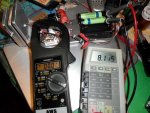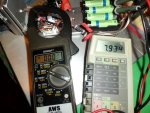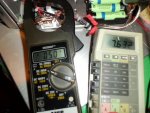Not really; 60A is the point where it bursts into flames. Bear in mind they will generate 10 times the heat at 60A as they do at 20A. If you're wiring a house or using it in an extension cord, the NEC allows 14awg for a 15A circuit. This is fairly conservative, and in my opinion it is okay operating at up to 30A or so, depending on if you can tolerate the extra heat and voltage drop.
Choosing a wire size depends on your design parameters. If you're okay with higher voltage drops and additional heat, smaller wire is fine. Most people seem to be content with pushing current just below the flash-point of the insulation, but wire is freely available from old electronics, so I don't see the need :undecided:
Flexible wire is generally used where the wire will be... flexed often. So I also don't quite understand why people use it for something that is flexed once.
How can you say that it is indeed the Flash Point of my wire and with the application we are using it as.? Are you sure.? Not all 14awg wire is equal right.? Are you talking about just standard wiring.? Maybe the standard PVC low strand count 14awg wire that your running 20,30,60+ feet of in a house that would fall true and your right but when it comes to high strand count wire some 14awg wire can handle alot more current with much higher temperature then others or any awg for that matter especially is Short lengths. No?
Does the voltage load matter too.? Iam sure it does.
I Cant even answer this question because i dont know what the max flash point is of the 14awg wire iam using to say if your right or wrong. i bought it from ebay and the wire says 200C on it.:thinking: At the very least its not getting anywhere close to 200C under mu conditions.
The Most Ive ever ran through it as a straight connection from diode supply to a 2.5V diode was 40A no clips. It got a little warmer then it did at 20A but far from flash point as i could still handle it just fine. I dont see an extra 10-20A making that much of a huge difference to catch fire to it in my case. So IMO 60A is not the Flash point of this wire that i have but i could be wrong.:undecided: Maybe under certain condition it is but not under mine.
None the less i keep it to Max 20A with no higher then a 12-15V load for the most part... SO iam fine. But i have used it in place for my Tiapan lasers a couple times and it works Just fine. I think it all depends on the length and the specific wire you are using in which you can get away with using higher awg.
Iam curious though now that you mentioned this too get the answer. Been trying to find the manf of this wire with no luck. Got any ideas.?

Its the Silicone 14awg wire you can get on ebay.
As for why use Silicone wire. I use flexible silicone wire over stuff like PVC wire because PVC wire melts with the Iron, its thicker and its harder to form into tight place and puts pressure on unwanted areas like diode pins.When using flexible silicone wire there is less risk of breaking a diode pin, ripping off a pad on the board and much easier to work with. Higher strand count too is a plus. Also Silicone wire has a Much higher temperature rating. Its also just about the same price in the bulk amount that i would buy so i prefer it.
LOL yes in fact I checked that all my lasers are at the best of their performances with Panasonic 18650 3400 mAh, but this last one is very current hungry ...
Do You suggest IMR AW or IMR SONY VT5?
The SXD can go down to 6.8V ~5A/5V load on the output. As i mentioned above Using Higher Mah cells vs IMR lower Mah cells comes out to be right about the same thing. But IMR cells are "Safer" since they can Handle more currant.
The Higher Mah cells Sag More
Vs
The IMR Lower Mah cells that dont Sag as much.
So to keep it short and sweet the cancel themselves out to basically being about the same run time when your talking about high current. Its Just the IMR cells Can handle more current so your not beating on them as much or getting them warmed up due to the internal resistance.
I stay away from VTC5 cells. There is alot of Fakes going around. Please search VTC5 fakes.
People say that they are still being made but IDK. Get HE2 cells. They are more then enough then what you would need.








